CONSTELLATION GUIDE
Last updated: 11 June 2001
CONSTELLATION GUIDE |
"GO TO"....SAGITTA and VULPECULA
The Archers "Errant Arrow" and the "Cunning Sky Fox"
From: sherrodc@ipa.net (Clay Sherrod)
In our sixteenth Constellation Guide, "GO TO SAGITTA and VULPECULA" of the series "GO TO GUIDES for the ETX and LX 90 Telescope Users" we will re-visit TWO constellations that were mentioned only briefly in my guide to the wonderful and large constellation of Cygnus -http://www.weasner.com/etx/ref_guides/cygnus.html) . After the last installment (Delphinus and Equuleus) http://www.weasner.com/etx/ref_guides/delphinus.html) in which deep sky objects were either at a premium or sparse at best, these two likewise SMALL constellations in the high northern sky provide an abundance of wonderful and challenging deep sky objects as well as an array of good variable and double star systems! So it's time to dust off the old AutoStar and put it to work....your challenge is more rewarding on this TOUR than last!
Sagitta (pronounced: "SAJ-eh-ta") is one of the few constellations that actually resembles what it is supposed to be. With constellations such as Sagitta and Vulpecula I envision early Greek stargazers and constellation-namers looking up at the dark night sky and realizing that they actually "....had stars LEFT OVER!" after assigning all the Greek gods and mythological heroes. What do you do with these stars? Particularly those that form such an obvious asterism as SAGITTA? Well, you find some way to "associate" those stars with an already-immortalized Greek hero that you HAVE named to the celestial firmament.
Sagitta is an "arrow" and that is indeed, what it looks like! The figure below shows the errant arrow, supposedly launched by our celestial archer SAGITTARIUS toward the threatening SCORPIUS (see my TOUR at http://www.weasner.com/etx/ref_guides/scorpius.html) , but as you can plainly see when standing outside on a dark night, he clearly missed his mark!

Note from the chart above that the stars ALPHA, BETA, DELTA and ZETA clearly define the arrow's feathered tail, while the shaft of the arrow is clearly delineated by the stars GAMMA and ETA. The magnitudes of the conspicuous "asterism" (star pattern) of Sagitta are give aside each star with the decimal point omitted to keep you from confusing that "dot" with a faint star (45 = magnitude 4.5). To be the smallest total area for any constellation, little Sagitta contains a wealth of fine double and multiple stars and some remarkable variables in addition to many fine deep sky objects!
To its north and east is the larger (but still small) constellation of VULPECULA (pronounced: vul-PECK-u-la) which, for whatever unknown reason, represents the cunning and ever-so-elusive Fox who prowls throughout the land and sky throughout the dark of night. I YOU can make a "fox" out of the only THREE (3) fairly dim stars seen with the naked eye of this constellation, you really have an imagination equally ONLY by those early Greek stargazers.
Nonetheless, Vulpecula is PACKED with objects, and only a smattering of them are presented here for lack of room. It is in this constellation that the famous "Dumbbell Nebula" (Messier 27) is found; this objects was discussed in the Cygnus TOUR noted above, but we will revisit this in length here.
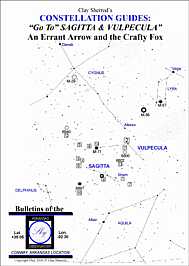
Each GO TO object is discussed for your telescope regarding the type of conditions necessary for you to view it optimally for discern the very faintest details....double star challenges for each size telescope .....magnifications and aperture necessary for most objects, and much, much more. This is YOUR complete GUIDE to get you on your way to exploring this large and interesting constellation. ONE THING that I might add about the region in and surrounding Sagitta and Vulpecula: Although some interesting and "test" double stars as well as VERY exciting variable stars are always included in the "GO TO" TOURS, there is a particularly wide range of very interesting double and multiple stars too numerous to list or mention here. Consult a good handbook, such as the "Burnham's Celestial Handbook," Vol. 1 for a very comprehensive list of locations, magnitudes and angular separations of these wonderful stars. There are many stars for EVERY telescope size and type. IN ADDITION, consult the wonderful wealth of information at www.aavso.org for complete details concerning all the fabulous variable stars and novae known for both Sagitta and Vulpecula; not only can you get great free observational information about these stars, but there are thousands of wonderful star charts FREE for downloading off that site; just go to "Standard Charts" then click on the appropriate RIGHT ASCENSION for each star that you would like to download comparison charts for, and they are yours for the effort!
Use this attached star chart and the following Guide as an excellent reference for your next star party itinerary, or a beginning for further study into the thousands of objects visible in this part of the sky. Truly these extensive Constellation Study Guides will most definitely put your AutoStar to work for you in the most efficient and enjoyable way possible! As a matter of fact, MANY AutoStar users are now programming their own "Tours" based on these guides, using each constellation as a separate GO TO Tour for the AutoStar library that can be added in or deleted through the main edit screen on your PC or MAC computer.
We hope you enjoy these comprehensive GUIDES to touring the constellations via your AutoStar and its computer-driven telescope. Each new installment is complete with diagrams, charts and illustrations that you will find nowhere else. Please let us hear YOUR feedback and your observations of each and every constellation after YOU have toured its vast reaches of our skies!
-----------------------------------
YOUR SAGITTA and VULPECULA CONCISE DIRECTORY OF INTERESTING OBJECTS -
The tiny sizes of these two constellations are deceiving when considering the great numbers of very fine objects within them. I have provided a comprehensive LISTING (similar to those for the many ngc galaxies visible in at least some of our GO TO telescopes for the constellations of Coma Berenices and Virgo (see: http://www.weasner.com/etx/ref_guides/coma-berenices.html and http://www.weasner.com/etx/ref_guides/virgo.html ). This listing is found at the end of our "concise list" of my selected top objects and gives an abbreviated description, position, magnitude and size of each of the brighter NGC (or other) object found in the two constellations.
For your specific "GO TO" TOUR I have chosen the finest 14 objects in Sagitta and Vulpecula; as with all GUIDES, all objects listed below will be visible in all telescopes (some naked eye) from the ETX 60 through the LX 90; of course larger apertures may "show" an object a bit closer and "better," but frequently a wide field and low power view is more desirable than aperture. You are encouraged to venture to your "dark sky site" for the BEST views of the many very faint ngc objects listed here. Even binoculars will show dozens of deep sky objects that cannot be fully appreciated in large telescopes with limiting fields of view! Remember that these two constellations - although not within the Sagittarius arm of the dense Milky Way cloud - are very close to the rich star clouds of our summer months and have some outstanding very low power star fields that are seen very well in the ETX 60 and 70!
The convenient sky placement of these two constellations lends itself well to very good and long-period observing for ETX and LX 90 users north of the equator. When rising about dark in the east (mid-spring) it will remain in the sky throughout the night, transiting the meridian at about midnight during that season. All deep sky objects and difficult double stars are ALWAYS best observed when they are located nearly overhead (or as high in the sky as possible), thus requiring the observer to look through the thinnest portion of the Earth's "lens" of atmosphere and haze.
As with all of the "GO TO" TOUR constellation lists, I recommend a good star atlas and/or chart which will list all the finest objects, constellation-by-constellation. One very handy reference guide is the PETERSON FIELD GUIDE TO THE STARS AND PLANETS, which features complete lists with declinations, right ascensions, magnitudes, and all pertinent information for you to expand your observing horizons beyond this brief GUIDE. For the computer, my favorite quick reference and very comprehensive descriptions of objects is by far the "deepsky2000" software available at: http://www.deepsky2000.net/ . Note that this very affordable software package ALSO allows very quick and accurate construction of "Go To" Autostar tours for these constellations as well as allows a very nice laptop control of any ETX or LX telescope!
Note that your AutoStar will NOT have every object listed on every constellation GO TO tour....this is intentional. You can access some of the most interesting objects of the sky directly from their coordinates. It is quite simple as you merely enter these coordinates as follows in the 10-step process:
1) Press the "MODE" key and hold down for 3 seconds and release;
2) Displayed will be the current Right Ascension and Declination of the center of field of view of where your telescope is presently pointed (assuming that you have properly aligned from "home position");
3) [NOTE: if you have the Meade electric focuser attached to any of the ETX or LX telescopes, holding down the "MODE" key will bring up the "Focus" command first....merely scroll (lower right scroll key) down one step to access the RA and DEC to enter your desired coordinates]
4) Press the "GO TO" button on AutoStar;
5) This will change the display and you will note the cursor blinking over the first digit of RIGHT ASCENSION (R.A.); merely use the number keys and dial in the R.A. of the object you are searching for;
6) When done, press "Enter;"
7) This moves the blinking cursor over the "DEC" coordinates;
8) [NOTE: the declination, unlike R.A., can be either positive or negative and you will see the "+" or "-" sign displayed depending on where your telescope is aimed at that time; if it is NOT the desired setting (plus or minus), merely use your arrow key to move the blinking cursor OVER the "+" or "-" sign and change by using either of your lower corner SCROLL KEYS;
9) Proceed to enter the DEC using number keys;
10) Press either "Enter" or "Go To" when finished and the telescope begins slewing to your desired object!!
The constellation tour Star Chart above (click on and save to a file on your PC; then open it and re-size to fit the page and print for a very handy at-the-scope star chart) will get you started on your journey for this constellation.
Following is the concise object list for your "GO TO" TOUR of Sagitta and Vulpecula; you may wish to find the majority of the objects from the AutoStar Library (for example, you can easily go to the "Dumbbell Nebula" if you pull up "Object/Deep Sky/Messier Object/..type in '27'...." and then press "Enter", followed by "GO TO" to access my favorite beautiful galactic cluster. On the other hand, if you want to experiment and become a "better AutoStar user" try entering the exact R.A. and DEC coordinates of that object as described above after holding down the MODE key. You will find the accuracy of entered GO TO's to be somewhat less than those stored in AutoStar, but the capability of acquiring unlisted objects is fantastic!
With more popular named objects, you can also find the Dumbbell and similar objects by going to: OBJECT / DEEP SKY / NAMED....and scrolling until you simply find "Dumbbell Nebula" and press enter, then GO TO.
OBJECT 1:
your not-so-bright index star - SHAM (alpha Sagittae) - R.A. 19h 38' / DEC + 17 54 - Magnitude: 4.4
OBJECT 2:
your index star in Vulpecula - (beta Vulpeculae) - R.A. 19h 27' / DEC + 24 34 - Magnitude: 4.6
OBJECT 3: (Sagitta)
super variable - V Sagittae - R.A. 20h 18' / DEC + 20 57 - Magnitude: 9.5 to 12, VERY erratic - FUN!
OBJECT 4: (Sagitta)
another great variable - FG Sagitta - R.A. 10h 10' / DEC + 20 11 - Magnitude: 9?? - one-of-a-kind!!
OBJECT 5: (Vulpecula)
good variable star - W Vulpeculae - R.A. 20h 08' / DEC + 26 08 - Magnitude: 8.2 to 10.2, semi-regular
OBJECT 6: (Sagitta)
great triple star! - Theta Sagittae - R.A.20h 08' ' / DEC + 20 46 - Mags: 6.2, 8.5, 7 very wide, EASY!
OBJECT 7: (Vulpecula)
great double star! - 2 Vulpeculae - R.A. 19h 16' / DEC + 22 56 - Magnitudes 5.4 & 9.5, great ETX 90 test!
OBJECT 8: (Vulpecula)
tough double! - 16 Vulpeculae - R.A. 19h 59' / DEC + 24 48 - Mags: 5.9 & 6.2 - REALLY close in LX 90!
OBJECT 9: (Sagitta)
globular? galactic cluster? - Messier 71 (ngc6838) - R.A. 19h 52' / DEC + 18 39 - Mag: 9 - NICE
OBJECT 10: (Sagitta)
planetary nebular - ngc6897 - R.A. 20h 08' / DEC + 16 46 - Mag. 11 - tough but do-able in the ETX 125+
OBJECT 11: (Vupecula)
very open cluster - ngc6800 - R.A. 19h 25' / DEC + 25 05 - Star Mags. 10th, nice, about 25 stars, open
OBJECT 12: (Vulpecula)
galactic cluster - ngc6940 - R.A. 20h 33' / DEC + 28 08 - Mag. 8.2, about 100 stars, each mag. 9.0!
OBJECT 13: (Vulpecula)
galactic cluster- ngc6802 - R.A. 19h 29' / DEC + 20 10 - Mag.11, bar shaped, 60 stars...nice in ETX 125+
OBJECT 14: (Vulpecula)
THE DUMBBELL NEBULA - Messier 27 (ngc6853) - R.A. 19h 57' / DEC + 22 35- Mag. 7.6, the BEST!!
OBJECTS 15 THROUGH 41 -NGC OBJECTS IN SAGITTA AND VULPECULA (other than those listed above)
listing of "ngc" objects in order of RIGHT ASCENSION (and NGC # order) visible in ETX and LX scopes:
NOTE: These NGC / IC objects are NOT detailed in the following "Visual Guide"
as are those Objects 1-14 listed above...use the abbreviated descriptions as they follow the order:
NGC# / R.A. / DEC / MAGNITUDE / SIZE (in minutes arc -'-) / DESCRIPTIONS (abbreviated)
IN SAGITTA:
ngc6838 / 19 52 / +18 39 / 9.0 / 5.5' - globular cluster, M-71 (see below)
ngc6879 / 20 08 / +16 46 / 11.0 / 5" - very tiny planetary nebula, looks like star - central star mag. 15
ngc6886 / 20 11 / +19 50 / 11.1 / 9' x 6' - large, but very dim. ETX 125 and LX 90 only (16th mag.centr.star)
IC4997 / 20 18 / +16 35 / 11.0 / 2" arc - starlike planetary, TINY. Central star is 14th mag (LX 90?)
H 20 / 19 51 / +18 13 / 9.6 / 10' diameter - large, about 20 11th mag. stars, very faint
IN VULPECULA:
ngc6800 / 19 25 / +25 05 / 9.7 / 15' - large (half moon size!) cluster of about 25 stars, all mag. 10
ngc6802 / 19 28 / +20 10 / 11.0 / 5' diameter - open cluster, small, about 60 13th mag. stars
ngc6823 / 19 41 / +23 12 / 10.0 / 5' - small galactic cluster with about 30 stars to mag. 11, nice
ngc6830 / 19 49 / +22 58 / 9.4 / 8' diam. - nice galactic cluster, 20 11th mag. stars, good object for ETX 90
ngc6834 / 19 50 / +29 17 / 10.1 / 4' diam -- small cluster, 50 stars at mag. 11 to 15 - LX 90 object
ngc6885 / 20 10 / +26 20 / 9.3 / 20' diam. - very large cluster, 30 stars + 6th mag one, good in low power.
ngc6940 / 20 33 / +28 08 / 8.2 / 20' diam. - NICE large cluster, 100 stars, mag 9 - great low power object!
ngc6842 / 19 53 / +29 09 / 12.5 / 50" diam. - very large planetary nebula, LX 90 only object - FAINT
ngc6853 / 19 57 / +22 35 / 8.0 / 8' x 5' - Dumbbell Nebula, M-27, see below!
IC1305 / 19 37 / +20 06 / 11.0 / 2' x 1' - nebula - very difficult and faint; good photographic object
IC4954 / 20 03 / +29 06 / 11.6 / 1' x 1' - nebula - small and VERY faint - maybe in the ETX 125, low power.
....AND NOW ON WITH THE SHOW!! (refer to the Star Chart for all the objects described in detail on the "Guide")
---------------------------------
A VISUAL GUIDE TO OUR DEEP SKY OBJECTS IN SAGITTA and VULPECULA
Object 1 - Our Starting Star in Sagitta - "Sham" (alpha Sagittae)
At magnitude 4.37, there is nothing particularly spectacular about this star; it is an "F" spectral type star, similar to our own sun and appears to be a single star as well. In the chart above you can see that Sham denotes the northernmost "feather" stars of the Sagitta arrow. You can keep looking.....but there really is not a whole lot more to see! (but don't you think THAT is exactly what astronomers on the planet circling Sham are telling folks looking our way at the Sun right now??).
Object 2 - Alpha Vulpeculae - Our Target Star for Vupecula
It's NOT a double star...it's not a variable star....it's not a bright star. But at magnitude 4.6 it IS the brightest object in the cunning fox Vupecula. Twice as close to us as our previous star, alpha Vul is a more evolved star than our sun, being a "G" spectral class. Keep looking.....nothing changes. However, you DO now know where Vulpecula is, don't you? I'll bet you could not have pointed it out before this "GO TO" TOUR!
Object 3 - A Very Interesting and Rewarding Variable Star - V Sagittae
This is an incredible and greatly erratic star as the light curve shown below can plainly demonstrate.
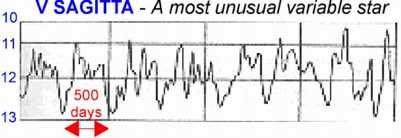
Known as one of the "cataclysmic variables" (see: http://www.weasner.com/etx/ref_guides/variable_stars.html ), V Sagittae is one of the most unusual of all irregular variable stars. Here are the facts: 1) the star is likely, like the famous SS Cygni, a double star which shares volatile gases with its companion, thereby resulting in "some" of the unpredictable light changes; 2) it can suddenly (within a day!) change brightness, up or down, by as much as THREE (3) magnitudes; and 3) it can flicker in magnitude within hours by as much as one magnitude. V Sag has no known "period" that is predictable, although some pattern might be imagined looking at the light curve above, with some rapid fluctuation occurring about every 96 days. It is an IDEAL object for the ETX 90 and larger scopes, as it fluctuates between magnitude 9.1 and 12 without notice. The irregular variable stars deserve MUCH attention on a NIGHTLY basis, and they are FUN to observe! You can actually see the Universe at work with these stars in only a short period of time.
This star is located about 9,000 light years away from Earth.
To locate the star, use the "b" finder chart from the AAVSO at http://charts.aavso.org/SGE/V_SGE/VSGE-B.GIF and once found (particularly when dimmer) use the narrow field "d" chart for comparison by downloading http://charts.aavso.org/SGE/V_SGE/VSGE-D.GIF to a file, resizing to print and print out a field star chart for this star! This is one variable star worth keeping up with!
Object 4 - A Totally Unique Variable(?) Star - A Star in the Making? - FG Sagittae
This may well be the most unique of all variable stars that you will observe; it does not change much, but just watching it routinely may pay off in the long run. You see, this star "started out" back in around 1870 as a very dim, perhaps 14th magnitude star of little interest. For many years it remained at 14th magnitude....then, around 1900, the star began to INCREASE its brightness very predictably (see the light curve below).
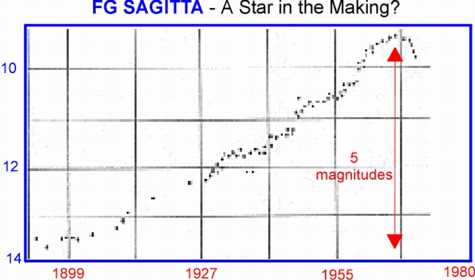
So far, it appears spectroscopically that this is a supergiant star, and it most definitely has been confirmed to have a large disk of nebulosity around the star, much like a planetary nebula. From the velocity of the disk's expansion and the distance of 8150 light years for the star, the shell - and the image of the star that produced it - is only about 3000 years old. Whether or not this is a star in formation.....or an extremely slow nova....there is nothing else out there quite like FG Sagittae.
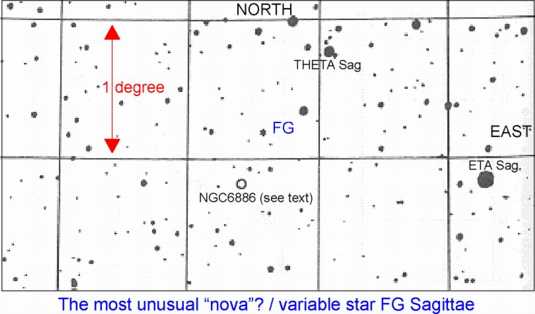
This is one variable star that the AAVSO does not have a confirmed comparison/finder chart for; this SAO adapted chart shows the position of FG. Note how it is located relative to Theta (up and to the right) and Eta (right and down a bit); this will greatly help you confirm this star since it forms a neat little triangle with these two brighter stars. REMEMBER....north is at the TOP and EAST to the RIGHT in an ETX or LX, so the chart is oriented correctly "up and down," but is a mirror image left-to-right.
Object 5 - W Vulpeculae - A nice Semi-Regular Variable Star
This star is well within reach of all telescopes and is an ideal object for study with the ETX 90, with its magnitude range of 8.3 to 10.2. Although it has a "period" from brightest to brightest again of some 234 days, it has major fluctuations in between and many times the period changes by many days, weeks or even months. This is a VERY "old" M-type Red Giant star and at brightest this color is clearly evident a medium power, particularly when comparing with many others stars in the same field of view in a wide field eyepiece. Since there is curiously no AAVSO chart for this important star, use the chart
http://charts.aavso.org/STANDARD/VUL/R_VUL/RVUL-B.GIF for "R Vulpeculae" for comparison as this is very close to the position of this target star.
Object 6 - Theta Sagittae - A Very Nice "Triple" Star
Although listed in many sources as a "double star", Theta Sagittae has a third OPTICAL companion that makes this a really nice and easy sight for our telescopes. The true "physical" double star pairs Theta (magnitude 6.5, at the "end" of the "arrow" in the figure at the beginning of this "GO TO" TOUR) and an 8.5 magnitude star about 12" arc distant, and easy target both in separation AND in magnitude for the ETX 60 and above telescopes! Use about 15x per inch for best views in all scopes. Although you will not have to "hunt" for it, look for the 8th magnitude companion star NW of Theta. The third, and more distant (optically) star is a 7th magnitude star that will be easy to spot 1.2' (minutes arc) SW of Theta; all but the last star are "F" type solar stars.....the 7th magnitude star is a very "late" spectrally RED star (it can be seen as such). For best views of the yellow-red color contrast between this and Theta, use about 20x per inch, or medium magnification.
Object 7 - Another Very Nice Double Star - "2 Vulpeculae" Great test for ETX 90!
This is a good test double star, with a separation of ONLY 2.0" (the theoretical resolution limit - "Dawes' Limit" - for the ETX 90 is 1.3" arc). The star 2 Vulpeculae is a relatively bright magnitude 5.4, while its optical companion (not a true double) is a relative faint 9.5, therefore making it a challenge NOT ONLY for the ETX 90, but perhaps the ETX 125 as well. Can YOU see the secondary star? The faint companion is due SE of the brighter star; try masking out the brighter star with a crosshair element eyepiece and you should see it just fine. The primary star of this is ALSO a variable star: ES Vulpeculae with an extremely rapid period of ONLY 0.609 days, changing from 5.4 to 5.5 rapidly. These changes are NOT visible to the naked eye, only through sensitive photoelectric and CCD electronic sensors. This is a very nice target for the LX 90.
Object 8 - Another Double - "16 Vulpeculae", but this one challenges even the LX 90! Not for the impatient!
Okay, all you "big dogs" with the LX 90's....try this one. Here is 16 Vulpeculae, a VERY difficult but definitely resolvable, double star. Its current separation is ONLY 0.8" arc, right at the limit of the 8" scope if you are very well collimated. The primary star is magnitude 5.5 and the secondary is very close to that, magnitude 6.2, and located just south of due east from 16 Vul. You will need the steadiest of nights and a rock-solid mount since you will have to "jack up" the magnification to around 400x to split this difficult object! By the way.....I know someone who has done this with the ETX 125 at 405x! Smaller scopes: don't even bother with this one.
Objects 9 - A Globular? A Galactic? A Globular? Messier 71 - An Unusual Star Cluster!
Here we have Messier 71. Look for this object halfway from Delta Sagittae to Gamma and only about 10 degrees due NORTH of the bright star Altair, in Aquila the Eagle. At present I cannot tell you that this is a globular (see photo from the Mt. Wilson 120" reflector below) OR perhaps a VERY compacted galactic cluster that "appears" to be a distant globular.
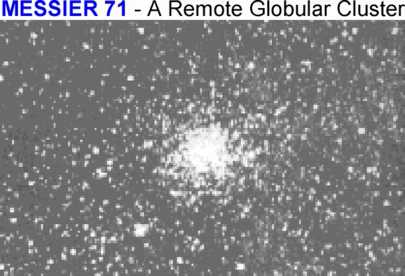
With the ETX 90 it appears as a fairly large and faint hazy patch of light, clearly visible on a dark night. At magnitude 8.9 and a fairly large 6' arc, this should be an easy object in that scope and also should be visible in the ETX 60 and 70. However, using the ETX 125 and LX 90, many stars of magnitudes 11 to 15 can clearly be seen in this interesting object. Look for another very interesting cluster - Herschel 20 - only about 1.5 degree SSW of M-71, clearly in the same field of view in a low power wide field eyepiece. H-20 is ALSO visible (see the NGC listing above) in the ETX 90 at low magnifications....it is about 10' arc across so it is very spread out! Although it is NOT known if this is a globular or galactic cluster, its distance of 18,000 light years suggest to me that this is indeed one of the many Milky Way companion globular clusters at the same distance and location.
Object 10 - A Very Faint and TINY Planetary Nebula - ngc 6897 in Sagitta
Here is one strictly for the larger telescope, ncg6897. This planetary nebula still exhibits its central star at magnitude 15.1. The nebula itself, at a brightness of only 11.2 (visual) is a very difficult object even in the ETX 125 and the LX 90 as it extends only a 5" arc diameter! Tiny! Thus, what you can expect to "see" here is something smaller than the planet Uranus looks at the same power. Look with the larger scopes for a very faint "out-of-focus-appearing" star with not much size to it; it will be clearly distinguishable from the many other stars seen in the field at an optimum magnification of about 180x to 225x since it will appear to have a small "glow" around it....other than that, there is not much detail visible. Remember, however, you are looking at an incredibly distant object - over 2,400 parsecs - that seems to be somehow "paired" with another planetary nebula only 3 degrees to its north, ngc6886 (see above listing) which also is visible in the ETX 125 and LX 90; both are located at the same distance from Earth.
Object 11 - A Very Large and Sparse Galactic Open Cluster - ngc6800 - ETX 70 is ideal scope
Here is an object that is magnitude 8.5 overall, but is spread out over such a large area (15' arc - about half the moon's diameter), that it actually is a very difficult object, particularly in large telescopes with narrow fields. The ideal scope for this might be the ETX 60 or better the 70, with its wide field of view and a magnification of around 50x. Only here can you get the "cluster effect;" in scopes with a more restricted field, the object appears to merely be many stars of about 10th magnitude spread out across the field of view. Look for this nice low-power cluster only 30' arc NW of alpha Vulpecula (see above), and note that there are about 25-30 stars ALL of around 10th magnitude that should be visible in all scopes.
Object 12 - A Very Nice Galactic Star Cluster in Vulpecula - ngc6940 - WHY is this NOT a Messier object?
This is a nice and usually overlooked object for small amateur telescopes, a large galactic star cluster containing at least 100 stars! All stars are in the 9th magnitude range so this is an EXCELLENT object for the ETX 60 and 70 as well as the larger telescopes using a very wide field of view since the cluster is spread out over a 20' arc area. Overall this is a very bright cluster, with a combined visual magnitude of 8.2; the stars and the true cluster effect should be witnessed in all telescopes, but like the previous object, low power and wide fields are desired for the best view....if you do NOT have dark skies, this object cannot be fully appreciated!
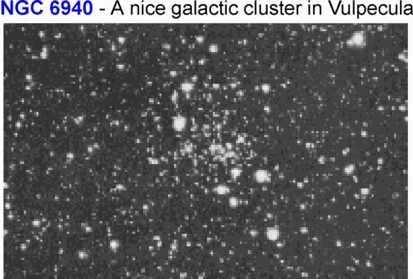
Object 13 - An Interesting Cluster with an Interesting Shape - ngc6802
Yet another galactic cluster in Vupecula, but this one is quite interesting, particularly in the ETX 125 and the LX 90....this one is shaped distinctly like a "bar," or an elongated rectangle. It is not at all as large as ngc6940 above, show an overall expanse of only 3.5' arc. Thus it requires some magnification to make out this shape as well as the very faint stars of magnitude 13 through 18. Although a few of the "brighter" stars will be glimpsed in the ETX 125, the rest will appear as a very faint 11th magnitude glow at medium-high (i.e., 160x to 200x) powers; the LX 90's greater light gathering and faster focal ratio will show more stars and perhaps be better suited to demonstrate the "bar" shape; I can barely detect this cluster as "....an oval glow" in the ETX 90 under very dark skies.
Object 14 - THE DUMBBELL NEBULA - Messier 27
Yes, we discussed this object in our "GO TO" TOUR of Cygnus (http://www.weasner.com/etx/ref_guides/cygnus.html ) since most people "think" this beautiful object is in that constellation, just off the "bottom" (southeast) of the Northern Cross star, Albireo. So for a full discussion of this BEST OF PLANETARY NEBULAE, I refer you to that constellation's guide. However, I was able to revisit this wonderful object on a very dark night at the Observatory and used a variety of telescopes on it.
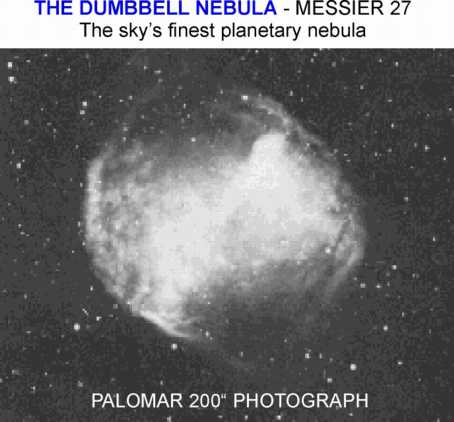
I was able to get an exceptional look at this object, which draws you back and back like a magnet in late May on a moonless night from the Mountain. With the LX 90 the magnitude 13.4 central star was clearly visible as was another slightly brighter star embedded (actually in the foreground) in one of the gaseous extensions. This star was clearly visible in the ETX 125 in moments of very good seeing, but the central star was never seen. There was detail within the gas cloud itself seen in both scopes at 100x (20mm eyepiece), making a gorgeous impression. I found that with all telescopes about 100x was ideal for this very large nebula. In the 24" at Newtonian focus this objects just blows you away, with countless striations of filamentary gases visible coming from the central star. M-27 literally fills the field of view of a 35mm Televue Panoptic eyepiece at f/4! Much of the visible detail, and the stars discussed can be seen in the wonderful photograph taken with the Palomar 200" telescope shown above.
In my opinion, Messier 27 is by far the most outstanding object of the summer skies (and there are plenty of contenders to choose among!)
--------------------------------
WANDERING ABOUT....YOUR NEW "USER OBJECT" IN VULPECULA
One of the skies BEST variable stars is found in the modest constellation of Vulpecula. R VULPECULAE is located at: R.A. 21h 02m / DEC +23 degrees 37m. NOTE that this variable is also included in your variable star database library on Autostar! Nonetheless this is a wonderful star for casual variable star observing that allows you to make periodic brightness estimates while cruising around the summertime skies! So for this installment of your "GO TO" TOURS we are going to add this (using the coordinates above) to the USER OBJECT library which we are compiling from these TOURS.
On AutoStar, go to: "Select/Object [enter]...." scroll down to "User Object" [ enter]. Now enter the coordinates given above for "R VUL", using the number keys on AutoStar. After entering the coordinates and pressing "Enter" yet again, scroll down one and you can list the magnitude of the object as "7.5"[Enter].
Now a bit about the object. For more detailed descriptions of it, consult the AAVSO at www.aavso.org for all their observing literature. To LOCATE among the field of stars and to COMPARE its changing brightness when "brightest", use: http://charts.aavso.org/VUL/R_VUL/RVUL-B.GIF which is the "b" low power and wide field chart to actually locate the actual star; once found and particularly when at its dimmest, use chart "d" for fainter comparison stars at http://charts.aavso.org/VUL/R_VUL/RVUL-D.GIF . Both charts should be saved to file, opened and resized (and saved again at that size if you wish) and then printed for use at the telescope.
R Vulpecula is a spectacular "short" long period variable star of only 136.82 days, ranging from a relatively bright 7.4 magnitude to 13.4, still easily visible in the ETX 125 on a very dark night; therefore the entire cycle of this wonderful star can be observed in about four months time! Even with the ETX 90 most of the cycle can be monitored, with the approaches to and brightening after minimum the only parts lost (about 14% of its cycle). One reason I have selected this star for your study is its COLOR: RED! This is an M-class very late star on the spectral evolutionary scale is demonstrates an incredibly scarlet color during most of its cycle and particularly during its brightest.
So with the addition of a this wonderful and rapid variable star, you are adding yet another among the curious multiple stars, variable stars and weird deep sky objects. All of these are wonderful for conversation-starters and crowd-stoppers at the big astronomical events!
Next Constellation GO TO" TOUR Installment: The incredibly LARGE and LONELY constellation of CAPRICORNUS, the "sea goat" (what??). Unless you may have been "born under the sign" of this faint and obscure constellation it is likely that you have not spent much time there. In the next installment.....you will see why. JUST KIDDING! We are going to concentrate mostly on DOUBLE and MULTIPLE stars in Capricorn as there are many fantastic such stars there! And one lowly Messier Object, the beautiful Messier 30, one of the finest globular clusters in the sky!
Good Observing and explorations of this wonderful world of deep space!
P. Clay Sherrod
Arkansas Sky Observatory
Conway / Petit Jean Mountain
Arkansas
Return to the top of this page.
Go back to the Observational Guides & References page.
Go back to my ETX Home Page.